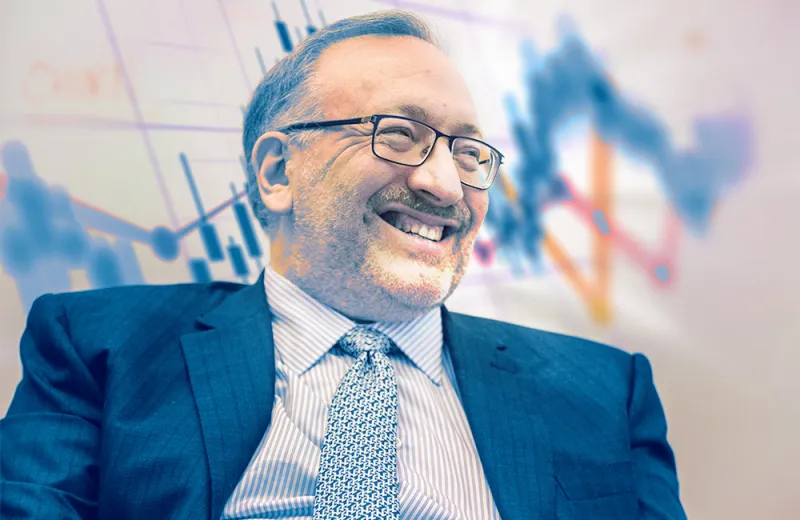Making changes to what’s universally known as the bible of value investing — even if it was originally published in 1934 — is big.
“There is a little bit of sacrilege in my chapter on balance sheet, which is basically saying that we ought to rethink this,” says Seth Klarman, the legendary investor and co-founder of The Baupost Group, a hedge fund, during an interview in New York after publication of the seventh edition of Benjamin Graham's & David Dodd’s Security Analysis, which has guided some of the world’s most successful investors, including Warren Buffett. Buffett studied Security Analysis in 1950 and 1951 with Graham and Dodd themselves at Columbia University. At its heart, value investing is simple — buying something for less than it’s really worth.
“Graham dealt with cyclical change. Graham dealt with ‘Oh shit, it’s a depression.’ In this world, it’s much more likely to be, ‘Oh shit, somebody else just figured something out and is disrupting this business,’” says Klarman, who edited the latest edition of Security Analysis. (His royalties will be donated to organizations working to increase diversity in asset management and finance in general, including Girls Who Invest, UNCF’s Lighted Pathways Program and Sponsors for Educational Opportunity.)
In Klarman’s introduction to the famous chapter, he explains that among other things, investors no longer get an edge from analyzing publicly available balance sheets. The advantage has been steamrolled by hyper competition from professional investors willing to spend enormous sums on R&D to find a money-making edge and the availability to everyone of endless streams of financial information and data.
The larger change for investors trying to calculate a margin of safety from balance sheets is technology. Klarman believes that tech in all its forms poses a bigger threat to portfolios than even a prolonged market downturn. “What is technology doing to this business — is it helping this business or is it killing off this business?” he said during the interview.
Still, Klarman, who became a believer in value investing during a summer internship during college at Max Heine’s value-driven Mutual Shares, may think balance sheet analysis is “less relevant,” but he’s not writing it off. He argues that the analysis gives investors a picture of how leveraged a company is — how much cash it holds — and helps identify red flags such as whether liabilities are growing faster than the business itself. “Graham and Dodd’s emphasis on book value may have been supplanted by newer metrics, but their focus on balance sheet analysis remains valid,” he writes in the chapter's introduction.
It was the right time to revisit Security Analysis. Klarman says he took on the job of editing the book to remind people that some basic principles could keep them out of trouble. Over the last 15 years, he believes that the markets have become a place for investors to speculate, even more so than in previous bull markets. He considers it his obligation to warn investors of the dangers, but he thinks the biggest pension funds and endowments may ignore it. “[I don’t] know how much of this will be read by institutional investors who may think they know it all.”
Security Analysis is not an instruction manual for investors, Klarman says in response to a question, quietly reflecting on what he thinks is a better comparison. “…I think maybe it’s like a marine corp training manual and what it basically says is — eat a healthy diet, stay in great shape, run 10 miles every chance you get, be true to your fellows on the team. Because it doesn’t tell you what stocks to buy or the right valuation….it’s like a plan, a framework for how to approach investing.”
Value, one of the most widely known and perhaps intuitive ways to invest, isn’t the largest. It goes against a lot of conventional wisdom and requires patience. Doubters — and believers — don’t think investors can hang on to a style that is often forced to weather long periods of underperformance. Value investors believe there are opportunities in undervalued stocks because markets are inefficient, despite decades of academic arguments to the contrary. Value believers blame (or, perhaps, thank) the cognitive errors that humans often make — the desire to hang with the in-crowd and to go along with what’s popular, to name just a few — for the inefficiency. And value adherents don't think human behavior will change. During the long period of value underperformance that ended in late 2021 or early 2022, critics argued that the world had changed and that the shift from companies running manufacturing plants to less tangible, harder-to-price assets such as intellectual property had broken value investing. Then, just when the style appeared to have defeated investors again, value roared back.
In a conversation with Institutional Investor, Klarman naturally fell into using the tenets behind the style to frame everything from whether someone can learn to be a value investor — or can only be born that way — to the persistence of market inefficiency and human behavior outside of finance.
There’s often a tension between sticking to a proven discipline like balance-sheet analysis and knowing when and how to change. As Klarman writes in the preface to the seventh edition, “How do you separate reality and enduring wisdom from what is ephemeral, protean, and illusory?”
Klarman has faced that question many times since Baupost's founding in 1982, even when many of his peers famously gave up on value when it looked as though it would never work again or simply rewrote the rules to fit the opportunities available in the current market. That’s because value investing — many would say all investing — is as much about human psychology as it is about analysis.
Some behaviors require apparent contradictions in thinking. Klarman argues that people need to have both a strong conviction in an idea and a willingness to let it go and change their mind. To address this difficulty — as well as other behaviors that can get value investors into trouble — Baupost has put some processes in place to protect people from themselves. For instance, Klarman looks broadly at sectors to spot big-picture opportunities and beat-up sectors and makes the final investment decisions. The firm’s approximately 60 analysts then dig deep into individual ideas: They have to find the confidence to ultimately believe that they know better than both the market and their competitors.
“The analyst needs to fall in love with positions — I just date the ideas,” he says.
But they also need to know when it’s over. Klarman says that it can be as simple as an investor coming across something better, or realizing once they’re in an opportunity that it’s not quite what they thought. Getting out is better, even if the price has changed for the worse, than simply hanging on.
To counteract the innate human talent for inventing reasons to hold on to their ideas despite bad or changing news, Baupost requires what it calls a “re-buy analysis.” When circumstances change, analysts use the new information to underwrite existing investments from scratch. Would they buy the same investments today? Baupost’s objective is not to hold investments forever; it’s to hold them until they’re no longer a good investment.
Although Baupost works hard to counter them, the persistence of cognitive biases are why markets are still inefficient, argues Klarman.
Security Analysis was written long before the Efficient Market Hypothesis, which posits that all information is baked into a stock’s price and nothing can be bought at less than its fair value, became gospel. Howard Marks, the co-chairman of Oaktree Capital Management and a contributor to the seventh edition, says that he was lucky to be an undergraduate at Wharton in the mid-1960s because the finance theory that came out of the University of Chicago Graduate School of Business was still new and not widely known. “Thus my time spent at Wharton didn’t include exposure to the Efficient Market Hypothesis, which told the next few generations of students of finance that there was no use for Security Analysis: a guidebook to the impossible task of beating the market,” he writes in his introduction to a section on “fixed value investments."
It might be the most familiar way to invest, but the bulk of money saved by institutional and retail investors isn’t managed this way. Index funds and efficient markets aren't to blame. One reason may be that value investing isn’t what does well when markets are manic and money is flooding asset managers. It also may be the pain that drives off investors, forcing their managers to sell at the worst time.
“Investors must be resolute in the face of withering criticism from clients, superiors, and their own self-doubt during protracted periods of underperformance,” Klarman writes in the preface.
“There’s cyclicality in investor preferences. When value investing is doing well it becomes more popular, people see the logic of it,” Klarman told Institutional Investor. “When it’s doing poorly, it becomes less popular because people want to make money right away.”
He tells a story about a summer analyst who turned down Baupost’s plum offer of a full-time job. The analyst had his reasons, including wanting to invest in private companies whose values are calculated quarterly, rather than daily.
Klarman explains, “He said, ‘I can’t stand the market giving me its judgment every day. I like private equity, where I just buy something and in five to seven years you sell it and make money.’” Klarman countered that public markets are better because you can buy it and do the same analysis, and if the market doesn’t like it for some reason, you get to buy more at a lower price." Private equity doesn't offer that chance; investors buy in at one price. "So which would you rather do?,” he asked the analyst, who apparently still preferred PE.
Can people be trained to be value investors — if they’re not wired that way? Klarman says in his own case he’s always been after something that is mispriced and a bit of a contrarian.
“My brain tends to invert sometimes. I tend to hear the dog that doesn’t bark. I'm always value oriented in other things I do — I’m equally interested in bargain purchases and finding something that is mispriced, or finding out why it’s mispriced.”
Then he tells what could be his origin story.
An avid coin collector as a kid, Klarman would read everything he could about his hobby. In 1965, the U.S. mint stopped using silver in dimes and quarters, and reduced the amount in half dollars, as the price of silver rose. In 1971, when Klarman was 14 and riding the New York City buses, he befriended the driver, who let him swap a current quarter for the more valuable pre-1965 pure silver coins in the bus’s fare box. He was buying the proverbial dollar at a discount.
As much as Klarman knows about behavioral mistakes, he still makes them.
“The one I’m guilty of the most…is when you’ve stayed with a position a long time and you still believe in the thesis but you’re starting to grow a little skeptical about 'will it ever work?' I think that the human tendency that I have that I shouldn’t have is to feel like…and this isn’t how I experience it but… maybe it owes you something. Maybe you’ll be a schmuck if you sell it now. You’ve waited all this time, you’ve paid your dues, it owes you. Stocks never owe you."








